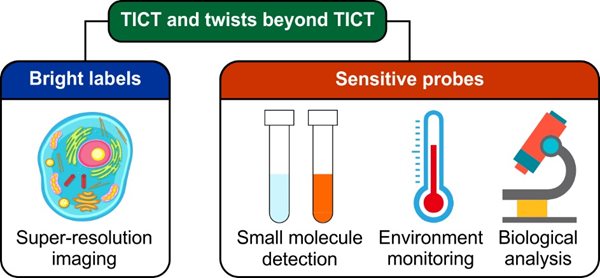Sparking new insights into dye chemistry
SUTD - Chao Wang, Weijie Chi, Davin Tan, and Xiaogang Liu
Dalian Institute of Chemical Physics - Qinglong Qiao and Zhaochao Xu
The SUTD-led study leverages systematic design and molecular engineering to develop brighter, more sensitive fluorophores used in detection probes and imaging labels.

Fluorophores, a chemical compound that can emit light, can be used as fluorescent labels for bioimaging, and fluorescent probes to detect a wide range of chemical species and physical parameters.
During twisted intramolecular charge transfer (TICT) - a photophysical process that occurs in many fluorophores – fluorescence gets extinguished. The donor and acceptor fragments of the fluorophore will twist to a nearly perpendicular conformation after photoexcitation, resulting in complete charge separation while transforming into a dark state.
However, molecular engineering of the fluorophore structure to suppress TICT can significantly enhance brightness and photostability. Additionally, environmental changes can modulate the formation of TICT in some flexible fluorophores, thus significantly altering the fluorescence signals. These alternations could in turn enable the quantitative detections of environmental parameters.
The Xiaogang Liu group from the Singapore University of Technology and Design (SUTD) and the Zhaochao Xu group from the Dalian Institute Chemical Physics conducted an extensive study on the TICT mechanism and explored ways on how to control it for brighter and more sensitive fluorophores.
They reviewed and systematically analysed the structure-property relationships of TICT fluorophores, and summarised design guidelines for tuning the tendency of TICT and modulating the fluorescence of these molecules.
Their study entitled 'Twisted intramolecular charge transfer (TICT) and twists beyond TICT: from mechanisms to rational designs of bright and sensitive fluorophores' was published in Chemical Society Review.
The researchers first briefly reviewed the proposal and the validation of the TICT model. They then summarised molecular design strategies of suppressing TICT to create bright and stable fluorophores for super-resolution imaging. Next, the authors reviewed the molecular design strategies of enhancing TICT for constructing fluorescent probes, including temperature sensors, viscosity probes, small molecule probes, protein sensors, DNA stains, RNA probes, and AIEgens. Finally, molecular twists beyond TICT were introduced, including twists in photon-induced electron transfer (PET) and twisted intramolecular charge shuttle (TICS). The authors also compared the differences between TICT, PET, and TICS.
Principal investigator, Assistant Professor Xiaogang Liu from SUTD believes that this study will contribute to the transformation of the dye chemistry, moving away from trial-and-error practices to the establishment and adoption of molecular engineering principles.
“Our research provides insights into structure-property relationships and design guidelines for dye chemists to rationally tune TICT, TICS, and PET in fluorophores for a wide range of applications,” explained Dr Liu. “We also hope that this paper will spark new discussions in designing novel luminescent fluorophores.”
Reference:
Twisted intramolecular charge transfer (TICT) and twists beyond TICT: from mechanisms to rational designs of bright and sensitive fluorophores, Chemical Society Reviews. (DOI: 10.1039/D1CS00239B)